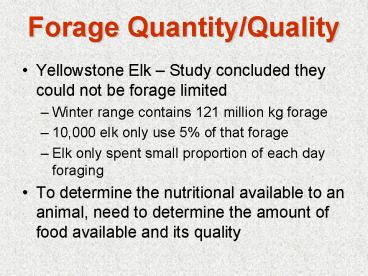Forage QuantityQuality PowerPoint PPT Presentation
1 / 20
Title: Forage QuantityQuality
1
Forage Quantity/Quality
- Yellowstone Elk Study concluded they could not
be forage limited - Winter range contains 121 million kg forage
- 10,000 elk only use 5 of that forage
- Elk only spent small proportion of each day
foraging - To determine the nutritional available to an
animal, need to determine the amount of food
available and its quality
2
Nutrient Analysis
- Organic compounds
- Carbohydrates (CHOs
- Non-structural Energy storage for plants
- Structural Cellulose, hemicellulose, pectin
- Protein
- Lipids High energy molecules
- Protective or defensive compounds
- Plant chemicals that reduce herbivory
- Dilute nutrients
- Reduce digestibility
- Affect animals metabolism (toxicity)
3
Plant Compounds
- Lignin large, aromatic, nonsaccharide polymer
that makes plant cell wall rigid - Not digestible by vertebrate or symbiotic
microbes. Common in woody plants gt some dicots gt
grasses - Reduces digestion of cellulose
- Cutin and subrin aromatic polymers resistant to
digestion. - Important in wound healing and as a physical
barrier. In woody plants, absent from grasses - Reduce digestion of cellulose.
4
Plant Compounds
- Silica
- Grasses, sedges, ferns and horsetail
- Secondary plant compounds
- Secondary to plants primary metabolism
- Extremely diverse (gt30,000 identified)
- Used as medicines and recently marketed as
supplements - 3 primary groups
5
Plant Compounds
- Soluble Phenolics Ring structures
- Flavanoids Give plant fruits, flowers, leaves
their color. Generally not toxic. - Isoflavanoids Some act as phytoestrogens
- Tannins most widespread SPC. Used to tan
animal hides because they bind w/ protein, making
it resistant to digestion. - Reduce protein digestion
- Maybe absorbed and be toxic
6
Plant Compounds
- Alkaloids Ring structures with at least 1
nitrogen. 10,000 alkaloids identified. Often
act by disrupting specific enzymes e.g.
nicotine, morphine, conine - Terpenoids Largest class of SPC (15-20,000
types). Insecticidal, antimicrobial, and toxic
effects. Often taste bitter. - Pyrethrin (insecticide in pet products)
- Problems for ruminants by affecting microbes
- Volatile oils of sagebrush and evergreens
7
Plant Compounds
- Glycosides Glucose based compounds.
- Cyanogenic glycosides release hydrogen CN
- Protease and amylase inhibitors Inhibit
digestive enzymes. - Soybeans have trypsin (protease) inhibitor
- Oxalates Molecules that bind minerals, esp. Ca.
May block kidney tubules - Prickly pear and rhubarb
- Unique CHOs and amino acids
- Raffinose in beans a.a. in leuceana
8
Forage Quantity
- Determine quantity of forage. Usually done by
clipping plots - Grasses and forbs clip all vegetation of
interest, dry, and weigh. May use double
sampling techniques. For detailed studies, may
collect species and even plant parts separately. - Shrubs clip edible vegetation in plot or
estimate shrub density and amount of available
forage/shrub. - Fruits/Mast Quantify amount/plot
9
Forage Quality
- Prepare sample for analysis
- Samples (gt10g?) of each distinct plant type you
will quantify. - Dry samples ASAP to stop plant metabolism. Dry
at 50 C. Color changes suggest problems - Could freeze samples, but then need to freeze dry.
10
Forage Quality
- Servello and Kirkpatrick, JWM forage prep data
11
Forage Quality
- Next step is grind samples in a mill, generally
over a 1 mm screen - Grind samples to homogenize and make analysis
possible - Conduct the analyses we have discussed
- Want to know what the animal can obtain from the
forage, so use chemical analyses to predict dry
matter digestion and protein digestion
12
Forage Quality
- Text from Hanley et al. 1992, Ecology 73
Digestible protein in mule deer
13
Forage Quality
- Fig. 1 from Hanley et al. 1992, Ecology 73
14
Forage Quality
- Fig. 2 from Hanley et al. 1992, Ecology 73
15
Forage Quality
- Text from Hanley et al. 1992, Ecology 73
Digestible dry matter in mule deer
16
Forage Quality
- Fig. on NDF digestibility from Robbins, 1992
Wildlife Nutrition Text
17
Forage Quality
- Fig. from Kirkpatrick vole data
Predicting digestible dry matter in voles
18
Forage Quality
Metabolizable energy in ruffed grouse
- Figs. From JWM 51560 (Servello and Kirkpatrick)
and JWM 59433 (Guglielmo et al.)
19
Forage Quality
- Other techniques
- In vitro digestion that we discussed earlier
- Total dietary fiber (data from bears and doves we
saw earlier) - Nylon bag technique
- Place forage sample in a nylon bag and place the
bag in the rumen of a fistulated animal for a
specified time (often 48 hours).
20
Forage Quality

